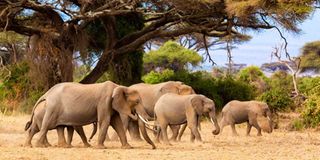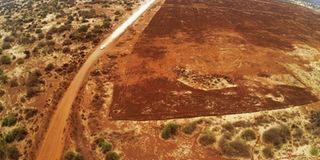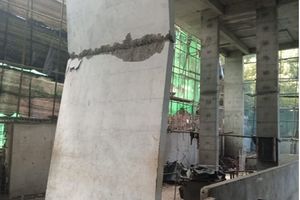Premium
What will the elephants of Amboseli eat? Avocados?

A herd of elephants.
What you need to know:
- A few years ago, Harji Mavji and Suresh Kurji Kerai, who own KiliAvo Fresh Limited, a horticultural venture, bought 180 acres of land in Ole Polos in Kimana, five kilometres from the Amboseli National Park.
- Records seen by the Sunday Nation indicate that KiliAvo legally acquired the piece of land from locals.
Red open earth, boulders and six-feet-tall timber posts on the perimeter of a 150-acre piece of land in the Kimana Community Conservancy appear out of place, even from the murram road towards Amboseli National Park. A family of gazelles and giraffes caught up in the melee still mill around the piece of land, now ploughed, that used to be their home.
At the centre of their displacement are two powerful businessmen who dream to make millions of cash from the land they intent to convert to a commercial avocado farm and vegetable orchard.
A few years ago, Harji Mavji and Suresh Kurji Kerai, who own KiliAvo Fresh Limited, a horticultural venture, bought 180 acres of land in Ole Polos in Kimana, five kilometres from the Amboseli National Park. The land lay idle for about four years, until two weeks ago, when tractors and earth movers rolled in to clear the bush and sink three boreholes.
Had local community members and wildlife conservation lobby groups in the Amboseli not publicly protested the move, the farm, which sits on a crucial wildlife corridor, would currently be teeming with verdant avocados, onions and tomatoes.
But how did this happen? How did the two businessmen get licence to set up such a huge farm here?
Records seen by the Sunday Nation indicate that KiliAvo legally acquired the piece of land from locals. Whether they knew that their farm lies within a wildlife migratory corridor that connects the Amboseli and Tsavo National parks, the largest and most popular tourist destinations in southern Kenya, is bewildering.
Conservation area
However, what is more mystifying is how the company secured a licence from the National Environment Management Authority (Nema) to put up a commercial crop farm in the middle of a conservation area without involving the Kenya Wildlife Service (KWS).
Nema was last week forced to stop the project following protest from KWS, members of the public and environmental lobby groups. Acting Director of Biodiversity, Research and Planning at KWS, Mr Patrick Omondi, told the Sunday Nation that due diligence in the issuing of the license was not followed. The process was also rushed, he said.
“Nema did not consult KWS in the process. We would not have approved it because it is an elephant dispersal area. Allowing a plantation inside a park would have made the corridor a human-wildlife conflict hotspot, since it would reduce movement space for elephants. This is not an agricultural area,” he said.

An aerial view of the disputed farm in Amboseli on September 24, 2020.
We put those questions and concerns to Nema, and in response the agency said it had realised much later that Mr Mavji and Mr Kerai had concealed critical in their application for farming licence.
“There were various areas of the feasibility study that they hid from us. Usually, a one-year study is done before any licence is issued,” said Mr Evans Nyabuto, chief corporate communications manager at Nema.
Following a public outcry, the authority’s director-general Mamo Boru on September 18 wrote to Mr Mavji and Mr Kerai and advised them to “immediately stop any further activities” on the land, and to “show cause within the next 10 days” why their licence should not be revoked.
Crop production
Mr Samuel Kaanki, the Amboseli Land Owners Conservancy Association chairperson, said there are six community conservancies in the Kimana wildlife corridor that operate under the Amboseli Land Owners Conservancy Association (Aloca).
“None of these zones allow commercial crop production,” said Mr Kaanki.
About 120 acres of the KiliAvo development fall within the wildlife conservation and tourism zone, while the other 60 acres fall within the livestock grazing and conservation zone.
The Amboseli National Park is approximately 100,000 acres, and the wildlife movement corridors and dispersal areas surrounding it are critical for the survival of wildlife in the park and the entire ecosystem.
Mr Daniel Ole Sambu, predator protection programme coordinator at Big Life Foundation, a non-profit conservation organisation focused on preserving the wildlife and habitats of the Amboseli-Tsavo-Kilimanjaro ecosystem, warned that any agricultural development that relies heavily on groundwater abstraction — with unknown impacts on local aquifers that feed community water springs — could adversely exacerbate the already existing human-wildlife conflict in the area.
The Sunday Nation has since established that a recent avocado trade deal between Nairobi and Beijing was the reason KiliAvo set up the farm since a ready export market already exists.
KiliAvo, however, is not alone in this race for farming profits. Across Kimana are a number of other agricultural developments in the wildlife corridor, all of which have been pushed through despite significant environmental damage and local resistance.
New constitution
For the longest time, Kajiado County, which is largely inhabited by Maasai pastoralists, had most of its land registered under group ranches.
Towards 2005, when the country made a failed attempt to have a new constitution, members of the community feared they would lose their land as the proposed constitution changed the group ranches to community land.
Group ranch members feared their land would go back to the ownership of the entire community, and therefore they agreed to sub-divide it. Once the pieces of land went into the hands of individual members, they began selling off their parcels to investors, especially from Nairobi, who paid them as little as Sh500, 000 for 60 acres.
Parcels of land in Kimana were sold cheaply because locals knew the area was not an agricultural zone, and was therefore less valuable.
As the demand and prices for fresh farm produce accelerated in Nairobi and other cities across the world, moneyed private investors flocked Loitokitok and Kimana to invest in agribusiness. Today there are dozens of commercial agricultural farms in Kimana and around Amboseli, among them Ngong Veg, which now grows French beans on 600 acres near the park.





